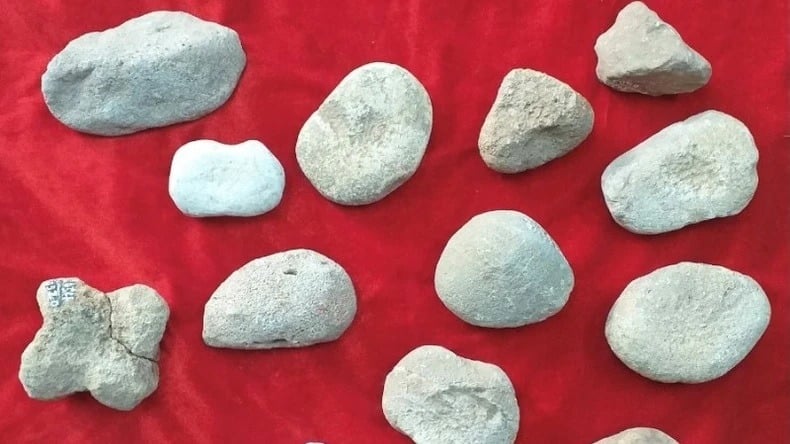 |
| Some stone tool artifacts of the Quynh Van culture are being preserved at Nghe An Museum. Photo: nhandan.vn |
Nghe An Museum, in collaboration with the University of Social Sciences and Humanities (Vietnam National University, Hanoi) and experts from the Faculty of Archaeology and Anthropology (Australian National University), conducted an archaeological excavation.
Specifically, in 2 excavation pits with a total area of nearly 20 m2, many precious artifacts dating back to prehistoric times were found, including: stone axes, flakes, pestles, stoves and animal bone fragments. These artifacts were identified as belonging to ancient residents who lived along the central coast of Vietnam thousands of years ago.
In particular, at pit number 2, the archaeological team discovered 9 sets of prehistoric human remains lying at a depth of about 3m below the ground. Most of the remains were buried in a kneeling position, densely distributed, about 50cm apart; of which 3 remains were stacked on top of each other and separated by a thin layer of soil, surrounded by layers of mollusk shells. Notably, some of the remains also contained jewelry made from seashells and snail shells. This shows that the residents of this period had quite developed beliefs and handicraft skills.
Initially, archaeological experts assessed that the discovery of many artifacts, especially the burial site this time, is one of the important discoveries, contributing to clarifying the historical and cultural value of the Quynh Van area - known as an important archaeological site with many meaningful discoveries about prehistoric times.
The artifacts and remains after this excavation will be tested by experts for radiocarbon - C14 to determine the age as well as to conduct in-depth research on the Quynh Van culture. After the results of the testing, the expert team will propose a larger-scale excavation in the near future.
Quynh Van culture belongs to the late Neolithic period, starting about 6,000 years ago and ending about 4,000 years ago, distributed mainly in the coastal plains of Nghe An and Ha Tinh; belongs to the type of scallop sandbar relics, 5 - 6m thick, large area, about 1 - 10 km from the sea.
The first was the discovery and excavation of a number of scallop mound sites in the Cau Giat area (Quynh Luu district, Nghe An province) in the years 1930 - 1932 by French scholars. Through the excavation of archaeologists in 1963 - 1964, 5 more scallop mound sites were discovered around the Quynh Van relic. In 1976, the Faculty of History, Hanoi University and in 1979 the Institute of Archaeology, during the exploration process, discovered 15 new sites belonging to the Quynh Van culture; of which 2 sites were excavated: Con Dat and Go Lap Bac (in Nghe An). To date, scientists have discovered 21 Quynh Van cultural sites. Traces of habitation include kitchens, burials, stone tools, bone objects, pottery fragments and many mollusk shells, showing a lifestyle closely linked to the sea and hunting and gathering activities of prehistoric coastal residents thousands of years ago.
In 2017, the Quynh Van archaeological site was ranked as a National Monument by the Ministry of Culture, Sports and Tourism.
According to baotintuc.vn
Source: https://baodanang.vn/channel/5414/202504/phat-hien-khao-co-quan-trong-ve-thoi-tien-su-tai-nghe-an-4005685/



![[Photo] Prime Minister Pham Minh Chinh receives Ambassador of the French Republic to Vietnam Olivier Brochet](https://vphoto.vietnam.vn/thumb/1200x675/vietnam/resource/IMAGE/2025/5/13/f5441496fa4a456abf47c8c747d2fe92)
![[Photo] President Luong Cuong awarded the title "Heroic City" to Hai Phong city](https://vphoto.vietnam.vn/thumb/1200x675/vietnam/resource/IMAGE/2025/5/13/d1921aa358994c0f97435a490b3d5065)
![[Photo] Many people in Hanoi welcome Buddha's relics to Quan Su Pagoda](https://vphoto.vietnam.vn/thumb/1200x675/vietnam/resource/IMAGE/2025/5/13/3e93a7303e1d4d98b6a65e64be57e870)

![[Photo] President Luong Cuong attends the inauguration of the international container port in Hai Phong](https://vphoto.vietnam.vn/thumb/1200x675/vietnam/resource/IMAGE/2025/5/13/9544c01a03e241fdadb6f9708e1c0b65)

















































































Comment (0)